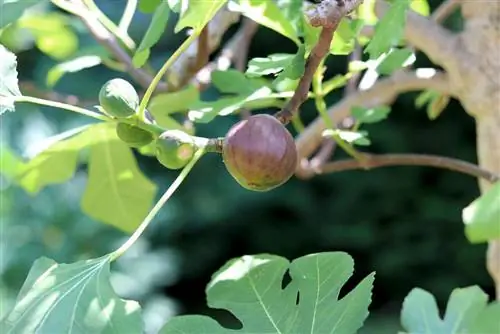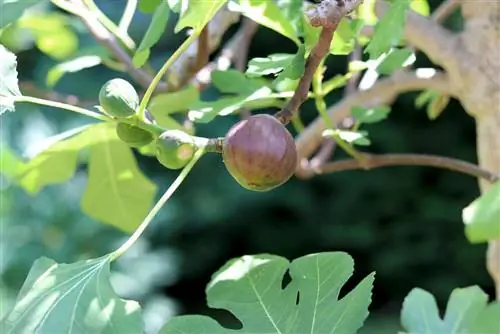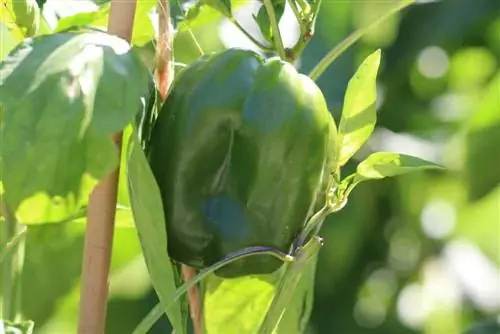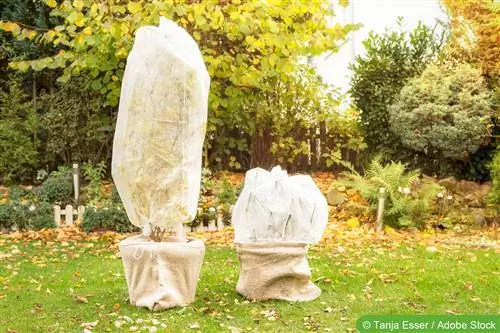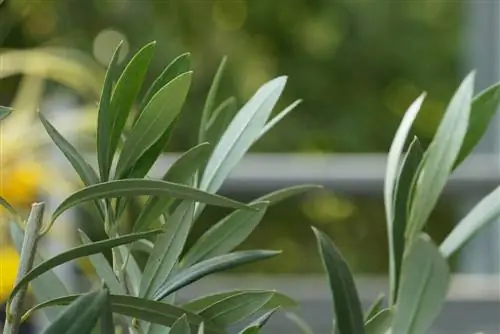- Author admin [email protected].
- Public 2023-12-17 03:39.
- Last modified 2025-01-24 12:45.
The sweet fruits of the Bavarian fig 'Violetta'® weigh up to 100 grams and contain many valuable vitamins and minerals. In contrast to many other types and varieties of figs, this special variety is hardy to a certain extent in a protected location and well packaged. However, it can also be easily cultivated in a sufficiently large container - for example on the balcony or terrace.
How frost hardy is the Bavarian fig 'Violetta'® really?
When it comes to winter hardiness, there are very contradictory statements about the Bavarian fig 'Violetta'®. Some garden shops describe it as “one of the few hardy figs”, and there are also claims that the plant is absolutely frost-proof at temperatures as low as minus 20 °C. In fact, the Bavarian fig 'Violetta'® is significantly less sensitive to frost than other types of figs, but it is and remains a Mediterranean plant - which is why its winter hardiness is not absolute, but only relative. Planting this type of fig is only recommended for regions with mild winters, such as the German wine-growing regions. However, the plant cannot tolerate harsh, snowy winters, which are typical in some areas of Germany.
Overwintering Bavarian fig 'Violetta'®
The Bavarian fig 'Violetta'® is considered comparatively robust, but this only applies to older specimens. Young fig trees, on the other hand, are still very sensitive, which is why planting them out, even in regions with mild winters, is only recommended when they are at least three years old. The younger the Bavarian fig 'Violetta'® is, the more comprehensive the specific winter protection must be. Older, established specimens, on the other hand, can cope with temperatures of up to minus ten degrees Celsius, as long as there is only short-term frost and not permanent frost. Planted fig trees can be protected against the cold in the following ways:
- Mulching the root area with leaves and/or straw (at least 50 centimeters thick)
- Wrap above-ground plant parts with fir branches or fleece
- complete wrapping from temperatures below minus ten degrees Celsius
- Pack potted plants as described when temperatures are around freezing point
- However, storage and frost-free wintering is recommended
Since the Bavarian fig 'Violetta'® is a deciduous and deciduous tree, frost-free overwintering can also be carried out in dark rooms (e.g. a cellar). The temperatures there are ideally between two and five degrees Celsius. Under no circumstances should it be warmer than ten degrees Celsius, otherwise the plant will wake up from its hibernation and become weakened.
Tip:
The older the Bavarian fig 'Violetta'® is, the less sensitive it is to frost. You can also harden the plant to a certain extent by leaving it outside a little longer each year in the fall and putting it out again earlier in the spring. In any case, you should keep the winter quarters as short as possible. Over time the plant gets used to the lower temperatures. However, planting in a warm living room is not recommended, as this weakens the plant and can hinder the ripening of the fruits.
Keeping as a potted plant

The Bavarian fig 'Violetta'® can be grown in a container without any problems. To ensure that the plant thrives and you can expect a delicious harvest, you should follow the following instructions:
- wide and deep planter, as many and long roots are formed
- nutrient-rich substrate and regular fertilization
- good drainage to avoid waterlogging
- Planting soil must not dry out, otherwise fruits will be dropped
- Shade planters if possible to avoid overheating
- a little frost is tolerated for a short time, but not permanent frost
Tip:
You can also bury the Bavarian fig 'Violetta'® in a suitable place in the garden using its planter - which is of course sufficiently large and has drainage holes in the bottom of the pot. This has the advantage that you can quickly dig up the plant when winter sets in and move it to more suitable winter quarters.
Location
The ideal location is
- warm
- sunny
- sheltered from the wind
In view of this description, cultivation in front of a south-facing wall is particularly recommended, but the problem here is that it can get too hot for 'Violetta'® very quickly. Make sure that the root area or the container is in the shade and that the plant is watered sufficiently. Basically, the rule applies that the sunnier the fig tree is, the more often it needs to be watered.
Tip:
Install a generous root barrier when planting the Bavarian fig 'Violetta'®. This prevents the roots from growing freely and thus ensures that the fig tree can be dug up again with an intact rootstock if necessary and moved to another location. In addition, unrestrained root growth hinders the development of the fruits.
Substrate
Like all figs, Ficus carica, as the Bavarian fig 'Violetta'® is botanically correctly called, requires permeable, loose and nutrient-rich soil. Normal, humus-rich garden soil is completely sufficient for planted specimens, as long as the soil is improved with ripe compost and horn shavings. Clay-containing soils, on the other hand, are too heavy and need to be loosened up (for example by generously enriching them with sand, topsoil and compost). Sandy soils, on the other hand, are far too poor in nutrients and should be improved with plenty of compost and topsoil. Specimens cultivated in pots thrive very well in good, nutrient-rich and loose potting or balcony plant soil. A special substrate for berry trees is also well suited.
Pouring
Fig trees like the Bavarian fig 'Violetta'® need plenty of water, especially during the summer months. Particularly in container specimens, it is important to avoid drying out of the substrate, otherwise the unripe fruits will be dropped. Therefore, water regularly and abundantly, with good drainage immediately draining away excess water and thus avoiding waterlogging, which is dangerous for the plant. However, the water that has run through should not remain in the saucer but should be removed as soon as possible. It is best to water the Bavarian fig 'Violetta'® after a finger test (the substrate is still dry about five centimeters deep when you stick your index finger into it) and thoroughly. Use stale, lukewarm tap water or collected rainwater.
Fertilize
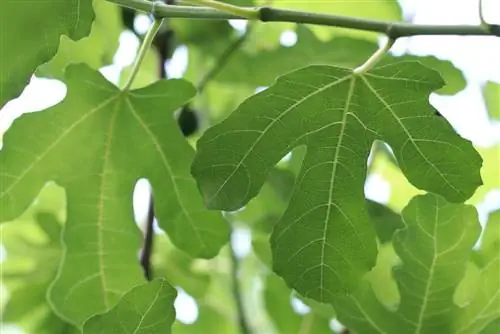
The Bavarian fig 'Violetta'® is not only thirsty, but also very hungry. Regular fertilization is therefore extremely important, although you should use organic fertilizer such as compost, stable manure and/or horn shavings for planted specimens. Alternatively, and for fig trees grown in pots, berry fertilizer is also very suitable. It is best to supply the plant with an appropriate slow-release fertilizer once in March, once in May and once in July, so that it is optimally supplied with all the necessary nutrients. However, a planted Ficus carica should no longer be fertilized later than the end of July, otherwise the young shoots will no longer be able to mature in time before winter and the plant is therefore particularly susceptible to frost damage.
Tip:
Water the Bavarian fig thoroughly after fertilizing, because this way the nutrients are washed more quickly to where they are absorbed: the roots.
Cutting
As with many fruit trees, regular pruning makes sense for the Bavarian fig 'Violetta'®, as this measure prevents it from aging and thus becoming bald. However, pruning may only be carried out immediately after the harvest, as the fruits are already attached to the previous year's branches in autumn - so pruning in autumn or spring would destroy the harvest. This rule applies to figs grown on espaliers as well as figs cultivated in bush or tree form. Shorten the shoots to around 20 centimeters and remove old, diseased and dead wood. This is removed close to the ground to make room for new shoots. Immediately after cutting, give the Bavarian fig 'Violetta'® another liquid berry fertilizer.
Diseases and pests
Diseases and pests only occur very rarely in the Bavarian fig 'Violetta'®. Problems such as yellow leaves, poor shoot growth, etc. are usually due to inadequate care - especially incorrect watering and / or fertilizing - or to overwintering that is too cold / too warm. Very rarely and mainly when kept in the winter garden, the fig can be attacked by the red spider, which in turn is also caused by inadequate care and thus a weak plant.

